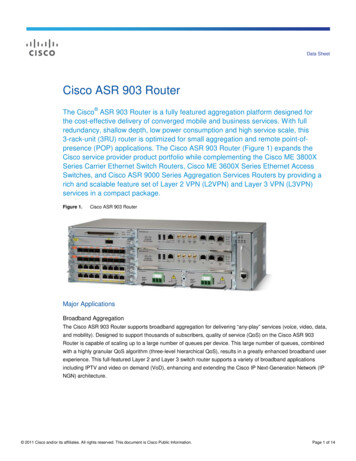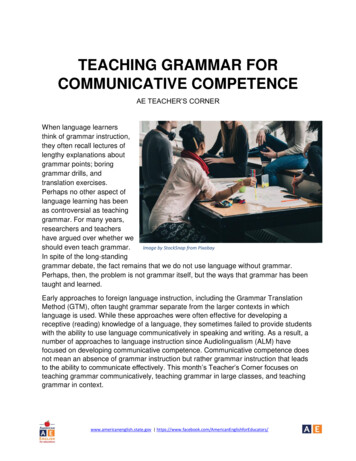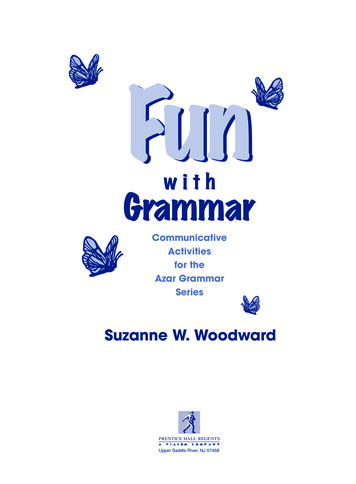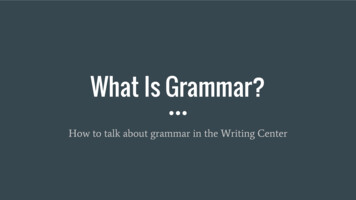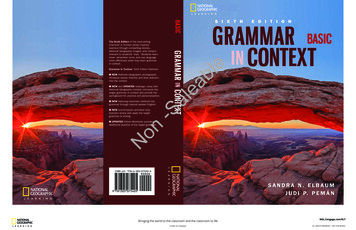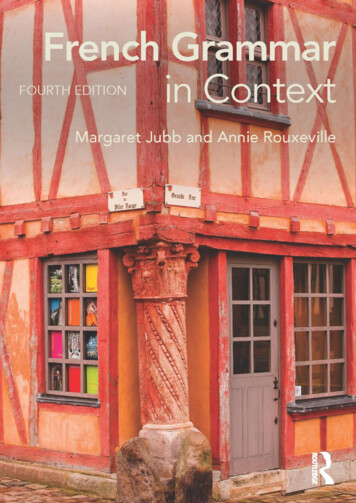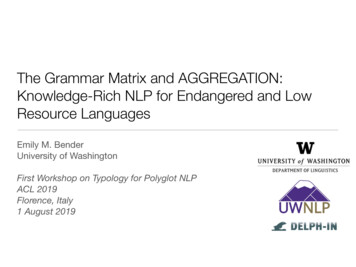
Transcription
The Grammar Matrix and AGGREGATION:Knowledge-Rich NLP for Endangered and LowResource LanguagesEmily M. BenderUniversity of WashingtonFirst Workshop on Typology for Polyglot NLPACL 2019Florence, Italy1 August 2019
Acknowledgments Grammar Matrix collaborators: Dan Flickinger, Stephan Oepen, Scott Drellishak,Laurie Poulson, Kelly O’Hara, Michael Goodman, Antske Fokkens, Joshua Hou,Safiyyah Saleem, Daniel Mills, Sanghoun Song, Joshua Crowgey, Scott Halgrim,Varya Gracheva, Laurie Dermer, Michael Haeger, Olga Zamaraeva, KristenHowell, Elizabeth Nielsen, Chris Curtis AGGREGATION collaborators: Fei Xia, Michael Goodman, Joshua Crowgey,David Wax, Olga Zamaraeva, Ryan Georgi, Kristen Howell, Michael Lockwood,Swetha Ramaswamy, Haley Lepp, Tifa Almeida, Claude Zhang Students in Ling 567 (since 2004) and 575 (2015) NSF grants BCS-0644097, BCS-1160274, BCS-1561833Any opinions, findings, and conclusions or recommendations expressed in this material are thoseof the author(s) and do not necessarily reflect the views of the National Science Foundation.
This talk in a nutshell Precision grammars model linguistic systems in a machine & human readableform The Grammar Matrix facilitates the development of precision grammars by combining the depth of formal syntax with the breadth of typology and provides a mapping from grammar specifications to precisiongrammars We can automatically (largely heuristically) derive grammar specifications fromannotations already provided by linguists, with applications to endangeredlanguage documentation
Grammar Engineering The development of grammars-in-software: morphology, syntax, semantics “Precision grammars” Encode linguistic analyses Human- and machine-readable Model grammaticality Map strings to underlying representations Can be used for both parsing and generation
Grammar Engineering: Frameworks Precision grammars have been built by/in/with HPSG in ALE/Controll (Götz & Meurers 1997; CoreGram: Müller 2015) LFG (ParGram: Butt et al 2002) F/XTAG (Doran et al 1994) SFG (Bateman 1997) GF (Ranta 2007) OpenCCG (Baldridge et al 2007) Proprietary formalisms and Microsoft and Boeing and IBM On implementation of MP, see e.g. Stabler 2001, Fong 2015, Herring 2016,also Torr et al 2019 (ACL)
DELPH-IN: Deep Linguistic Processing in HPSGInitiative (www.delph-in.net) Informal, international consortium established in 2002 Shared repository of open-source, interoperable resources Framework/formalisms: Head-Driven Phrase Structure Grammar (HPSG; Pollard & Sag 1994) Minimal Recursion Semantics (MRS; Copestake et al 2005) DELPH-IN joint reference formalism (Copestake 2002a)
DELPH-IN: Deep Linguistic Processing in HPSGInitiative (www.delph-in.net) Grammars: ERG (Flickinger 2000, 2011); Jacy (Siegel, Bender & Bond 2016);SRG (Marimon 2010); gCLIMB (Fokkens 2014); Indra (Moejadi 2018); . Parsing & Generation: LKB (Copestake 2002b); PET (Callmeier 2002); ACE(http://sweaglesw.org/linguistics/ace); Agree (Slayden 2012) Regression testing: [incr tsdb()] (Oepen 2001) Treebanking: Redwoods (Oepen et al 2004), FFTB (Packard 2015) Applications: e.g., MT (Oepen et al 2007), QA from structured knowledgesources (Frank et al 2007), Textual entailment (Bergmair 2008), ontologyconstruction (Nichols et al 2006) and grammar checking (Suppes et al 2012),robot control language (Packard 2014), sentiment analysis (Kramer & Gordon2014), .
HPSG in one slide
HPSG in one slide Key references: Pollard & Sag 1987, Pollard & Sag 1994, Sag, Wasow &Bender 2003 (textbook)
HPSG in one slide Key references: Pollard & Sag 1987, Pollard & Sag 1994, Sag, Wasow &Bender 2003 (textbook) Phrase structure grammar: Like CFG but with elaborate feature structuresinstead of atomic node labels
HPSG in one slide Key references: Pollard & Sag 1987, Pollard & Sag 1994, Sag, Wasow &Bender 2003 (textbook) Phrase structure grammar: Like CFG but with elaborate feature structuresinstead of atomic node labels Monostratal/surface oriented: One structure per input item (no movement),with both syntactic and semantic information
HPSG in one slide Key references: Pollard & Sag 1987, Pollard & Sag 1994, Sag, Wasow &Bender 2003 (textbook) Phrase structure grammar: Like CFG but with elaborate feature structuresinstead of atomic node labels Monostratal/surface oriented: One structure per input item (no movement),with both syntactic and semantic information Lexicalist: Rich information in lexical entries ( type hierarchy to capturegeneralizations)
HPSG in one slide Key references: Pollard & Sag 1987, Pollard & Sag 1994, Sag, Wasow &Bender 2003 (textbook) Phrase structure grammar: Like CFG but with elaborate feature structuresinstead of atomic node labels Monostratal/surface oriented: One structure per input item (no movement),with both syntactic and semantic information Lexicalist: Rich information in lexical entries ( type hierarchy to capturegeneralizations) Core & periphery: Construction inventory includes both very general and veryidiosyncratic rules
Minimal Recursion Semantics in one slide
Minimal Recursion Semantics in one slide Key references: Copestake et al 2005, Bender et al 2015
Minimal Recursion Semantics in one slide Key references: Copestake et al 2005, Bender et al 2015 Underspecified description of logical forms
Minimal Recursion Semantics in one slide Key references: Copestake et al 2005, Bender et al 2015 Underspecified description of logical forms Captures predicate-argument structure, partial constraints on quantifierscope, morpho-semantic features
Minimal Recursion Semantics in one slide Key references: Copestake et al 2005, Bender et al 2015 Underspecified description of logical forms Captures predicate-argument structure, partial constraints on quantifierscope, morpho-semantic features Computationally tractable, grammar-compatible, and linguistically expressive
English Resource Grammar (Flickinger 2000, 2011)erg.delph-in.net Under continuous development since 1993 Broad-coverage: 85-95% on varied domains: newspaper text, Wikipedia, biomedial research literature (Flickinger et al 2010, 2012; Adolphs et al 2008) Robust processing techniques enable 100% coverage Output: derivation trees paired with meaning representations in the MinimalRecursion Semantics framework---English Resource Semantics (ERS) Emerging documentation at moin.delph-in.net/ErgSemantics
English Resource Grammarerg.delph-in.net 1214 release: 225 syntactic rules, 70 lexical rules, 975 leaf lexical types Generalizations captured in a type hierarchy Both ‘core’ (high frequency) and ‘peripheral’ constructionshead subj phrase : basic head subj phrase &[ HD-DTR.SYNSEM.LOCAL.CAT.VAL.SUBJ #synsem ,NH-DTR.SYNSEM #synsem ].
English Resource Grammarerg.delph-in.netmodgap rel cl : basic non wh rel cl &[ SYNSEM.LOCAL.CAT.HEAD.MOD [ LOCAL.CAT.HEAD noun,--MIN modable rel,--SIND #mind ] ,ARGS [ SYNSEM[ LOCAL.CONT.HOOK.INDEX.SF prop,NONLOC.SLASH 1-dlist &[ LIST mod-local &[ CAT.HEAD mobile & [ MOD synsem ],CONT.HOOK [ LTOP #sltop,INDEX #slind & [ SORT location ],XARG #xarg ] ] ] ] ] ,ORTH [ FROM #from, TO #to ],C-CONT.RELS ! prep relation &[ LBL #sltop,PRED loc nonsp rel,ARG0 #slind & [ E [ TENSE no tense,ASPECT no aspect ] ],ARG1 #xarg & event or index,ARG2 #mind & [ SORT basic-entity-or-event ],CFROM #from, CTO #to ] ! ].
English Resource Grammarerg.delph-in.netbasic head subj phrase : head nexus rel phrase & head final infl & phrasal &[ SYNSEM [ LOCAL [ CAT.VAL [ COMPS ,SPR ,SUBJ *olist* & anti synsem min ,SPEC #spec,SPCMPS ],CONJ cnil ],MODIFD.RPERIPH #rperiph,PUNCT.PNCTPR #ppair ],HD-DTR.SYNSEM [ LOCAL.CAT [ VAL [ COMPS ,SPR *olist*,SPEC #spec ],MC na ],MODIFD.RPERIPH #rperiph,PUNCT [ LPUNCT pair or no punct,PNCTPR #ppair ] ],NH-DTR.SYNSEM canonical synsem &[ LOCAL [ CAT [ HEAD subst,VAL [ SUBJ *olist or prolist*,COMPS ,SPR *olist* ] ] ],NONLOC [ SLASH 0-dlist,REL 0-dlist ],PUNCT [ LPUNCT pair or no punct,RPUNCT comma or rbc or pair or no punct,PNCTPR ppair ] ] ].
ERG: Examples
ERG: Examples
ERG: Examples
ERG: Examples
Pen and paper syntax work-flowIdentify keyexamplesDevelopanalysisIdentifyphenomena toanalyzeIdentify casesof interestingpredictionsRefineanalysisTest acceptability ofnew key examples
Grammar engineering work flow(Bender et al 2011)Developinitial testsuiteIdentifyphenomenato analyzeDevelopanalysisExtend test suitewith isParse fulltest suiteDebugimplementationParse samplesentencesCompilegrammar
LinGO Grammar Matrix:Motivations and early history Speed up grammar development Initial context: Project DeepThought Leverage resources from resource-rich language to enhance NLP forresource-poor languages Claim: Some of what was learned in ERG development is not Englishspecific Interoperability: a family of grammars compatible with the same downstreamprocessing tools
Grammar Matrix:Motivations and early history With reference to Jacy (Siegel et al 2016), strip everything from ERG(Flickinger 2000, 2011) which looks English-specific Resulting “core grammar” doesn’t parse or generate anything, but supportsquick start-up for scaleable resources (Bender et al 2002) Used in the development of grammars for Norwegian (Hellan & Haugereid2003), Modern Greek (Kordoni & Neu 2005), Spanish (Marimon 2010) andItalian Used as the basis of multilingual grammar engineering course at UW (Ling567): 123 languages since 2004
Grammar customization: Motivations The Grammar Matrix core grammar is not itself a functioninggrammar fragment can’t be directly tested Human languages vary along many dimensions, but not infinitely Can be seen as solving many of the same problems in different ways Many phenomena are “widespread, but not universal” (Drellishak, 2009) we can do more than refining the core Also, grammar engineering lab instructions started getting mechanistic
LinGO Grammar Matrix Customization System(Bender & Flickinger 2005, Drellishak 2009, Bender et al 2010)Elicitation of enerationQuestionnaire(accepts userinput)Choices ysesCustomizationCustomizedgrammar
LinGO Grammar Matrix Customization System(Bender & Flickinger 2005, Drellishak 2009, Bender et al 2010)Elicitation of ionnaire(accepts userinput)HTMLgenerationChoices -in.net/matrix/customize/matrix.cgi
Current and near-future libraries (1/2) Word order (Bender & Flickinger 2005, Fokkens 2010) Coordination (Drellishak & Bender 2005) Agreement in coordination (Dermer ms) Matrix yes-no questions* (Bender & Flickinger 2005) Morphotactics (O’Hara 2008, Goodman 2013) Case ( direct-inverse marking) (Drellishak 2009) Agreement (person, number, gender) (Drellishak 2009) Argument optionality (pro-drop) (Saleem & Bender 2010) Tense and aspect (Poulson 2011) Sentential negation (Bender & Flickinger 2005, Crowgey 2012)
Current and near-future libraries (2/2) Information structure (Song 2014) Adjectives (attributive, predicative, incorporated) (Trimble 2014) Evidentials (Haeger7) Valence alternations (Curtis 2018) Adnominal possessives (Nielsen 2018) Nominalization (Howell et al 2018) Adverbial clauses (Howell & Zamaraeva 2018) Clausal complements (Zamaraeva et al 2019) Wh- questions (Zamaraeva in progress)
Creating a library for the customization system Choose phenomenon Implement analyses in tdl Review typological literature onphenomenon Develop questionnaire Refine definition of phenomenon Conceptualize range of variationwithin phenomenon Review HPSG (& broader syntactic)literature on phenomenon Pin down target MRSs Develop HPSG analyses for eachvariant Extend python backend Run regression tests Test with pseudo-languages Test with illustrative languages Test with held-out languages Add tests to regression tests Add to MatrixDoc pages
(Bender 2016)
Typology and the Grammar Matrix Typological surveys provide critical knowledge about the range of variation forspecific linguistic phenomena Implementation in the Grammar Matrix puts analyses of all of those variantsinto a system où tout se tien with all of the other implemented phenomena Implementation in the Grammar Matrix allows for evaluation on held outlanguages
AGGREGATION Project:Motivation & overview Precision grammars are potentially useful for endangered languagedocumentation (Bender et al 2012) Field linguists produce extremely rich annotations in the form of interlinearglossed text The Grammar Matrix provides a mapping from grammar specifications toprecision grammars Can we infer sufficiently accurate and complete grammar specifications fromIGT?
RiPLes: Leveraging IGT (Xia & Lewis 2007, Lewis & Xia2008, Xia & Lewis 2009, Georgi 2016) Interlinear glossed text (IGT) is an extremely rich data type IGT exists in plentiful quantities on the web, even for low resource languages Example from Chintang [ctn]:akka ita khurehẽakka ita khur-a-N-e1s brick carry-pst-1ss/p-ind.pst‘I carried bricks.’ [ctn] (Bickel et al., 2012)
RiPLes: Leveraging IGT (Xia & Lewis 2007, Lewis & Xia2008, Xia & Lewis 2009, Georgi 2016) Interlinear glossed text (IGT) is an extremely rich data type IGT exists in plentiful quantities on the web, even for low resource languages Example from Chintang [ctn]:akka ita khurehẽakka ita khur-a-N-e1s brick carry-pst-1ss/p-ind.pst‘I carried bricks.’ [ctn] (Bickel et al., 2012)
RiPLes: Leveraging IGT (Xia & Lewis 2007, Lewis & Xia2008, Xia & Lewis 2009, Georgi 2016) Interlinear glossed text (IGT) is an extremely rich data type IGT exists in plentiful quantities on the web, even for low resource languages Example from Chintang [ctn]:akka ita khurehẽakka ita khur-a-N-e1s brick carry-pst-1ss/p-ind.pst‘I carried bricks.’ [ctn] (Bickel et al., 2012)
RiPLes: Leveraging IGT (Xia & Lewis 2007, Lewis & Xia2008, Xia & Lewis 2009, Georgi 2016) Interlinear glossed text (IGT) is an extremely rich data type IGT exists in plentiful quantities on the web, even for low resource languages Example from Chintang [ctn]:akka ita khurehẽakka ita khur-a-N-e1s brick carry-pst-1ss/p-ind.pst‘I carried bricks.’ [ctn] (Bickel et al., 2012)
-IND.PSTIboughtapairofprpvbddtnninnp-subj-prpshoe .nnnpnppp.np-objvps(IGT from Bickel et al 2012)
Bender et al 2013: Inferring large-scale propertiesTask 1: Major constituent word order Count word order patterns inprojected trees Calculate ratios of OS:SO etc Plot points for each language in 3Dspace Compare to hypothesized canonicalpoints for each word order V2 (and not free) if SVO,OVS SOV,OSV
Wax 2014, Zamaraeva 2016, Zamaraeva et al 2019:Learning lexicons & morphological systems General parameters like word order alone won’t lead to a usable grammar Also required: lexicon and morphotactics (and morphophonology ) Create lexical rules for each morpheme, with associated form andmorphosyntactic and morphosemantic features Group morphemes into position classes Determine ordering relations Lexicon: part of speech, case frame, argument optionality
Lepp et al 2019: Visualizing inferred morphotactics
Lepp et al 2019: Visualizing inferred morphotactics
End-to-end evaluation with Chintang [ctn](Zamareva et al 2019)
Extending inference: Howell (in progress) Previously available: major constituent word order, case systems, case framesfor verbs, case values for nouns Adding: argument optionality, coordination, PNG on nouns and agreeingcategories, tense/aspect/mood, sentential negation, adverbial subordinateclauses Initial system tested in Ling 567 as starting grammar specifications (noisy!) Testing on 15 languages: 5 dev, 5 initial held-out, 5 more held-out Coverage, ambiguity, treebanked accuracy
External resources: WALS &c To what extent do the features in WALS map to Grammar Matrix grammarspecifications? (Almeida et al 2019) Where they do map, what is the best way to leverage them in inference ofgrammar specifications? (Zhang et al 2019) What about AUTOTYP (Bickel & Nichols 2002)?
This talk in a nutshell Precision grammars model linguistic systems in a machine & human readableform The Grammar Matrix facilitates the development of precision grammars by combing the depth of formal syntax with the breadth of typology and provides a mapping from grammar specifications to precisiongrammars We can automatically (largely heuristically) derive grammar specifications fromannotations already provided by linguists, with applications to endangeredlanguage documentation
ReferencesAckema, Peter, Patrick Brandt, Maaike Schoorlemmer, and Fred Weerman (Eds.). 2006. Argumentsand Agreement. Oxford: Oxford University Press.Adolphs, Peter, Stephan Oepen, Ulrich Callmeier, Berthold Crysmann, Dan Flickinger, and BerndKiefer. n.d. Some fine points of hybrid natural language parsing. In Proceedings of the 6thInternational Conference on Language Resources and Evaluation.Baldridge, Jason, Sudipta Chatterjee, Alexis Palmer, and Ben Wing. 2007. DotCCG and VisCCG:Wiki and programming paradigms for improved grammar engineering with OpenCCG. InT. H. King and E. M. Bender (Eds.), Proceedings of the GEAF 2007 Workshp, Stanford, CA.CSLI.Baldwin, Timothy, John Beavers, Emily M. Bender, Dan Flickinger, Ara Kim, and Stephan Oepen.2005. Beauty and the beast: What running a broad-coverage precision grammar over the BNCtaught us about the grammar — and the corpus. In S. Kepser and M. Reis (Eds.), LinguisticEvidence: Empirical, Theoretical, and Computational Perspectives, 49–69. Berlin: Mouton deGruyter.Bateman, John A. 1997. Enabling technology for multilingual natural language generation: theKPML development environment. Journal of Natural Language Engineering 3:15–55.Bender, Emily M. 2008. Evaluating a crosslinguistic grammar resource: A case study of Wambaya.In Proceedings of ACL-08: HLT, 977–985, Columbus, Ohio, June. Association for Computational Linguistics.Bender, Emily M. 2016. Linguistic typology in natural language processing. Linguistic Typology20:645–660.Bender, Emily M., Joshua Crowgey, Michael Wayne Goodman, and Fei Xia. 2014. Learning grammar specifications from igt: A case study of chintang. In Proceedings of the 2014 Workshop onthe Use of Computational Methods in the Study of Endangered Languages, 43–53, Baltimore,Maryland, USA, June. Association for Computational Linguistics.Bender, Emily M., Scott Drellishak, Antske Fokkens, Laurie Poulson, and Safiyyah Saleem. 2010.Grammar customization. Research on Language & Computation 1–50. 10.1007/s11168-0109070-1.Bender, Emily M., and Dan Flickinger. 2005. Rapid prototyping of scalable grammars: Towardsmodularity in extensions to a language-independent core. In Proceedings of the 2nd International Joint Conference on Natural Language Processing IJCNLP-05 (Posters/Demos), JejuIsland, Korea.Bender, Emily M., Dan Flickinger, and Stephan Oepen. 2002. The grammar matrix: An opensource starter-kit for the rapid development of cross-linguistically consistent broad-coverageprecision grammars. In J. Carroll, N. Oostdijk, and R. Sutcli e (Eds.), Proceedings of theWorkshop on Grammar Engineering and Evaluation at the 19th International Conference onComputational Linguistics, 8–14, Taipei, Taiwan.
Bender, Emily M., Dan Flickinger, and Stephan Oepen. 2011. Grammar engineering and linguistichypothesis testing: Computational support for complexity in syntactic analysis. In E. M.Bender and J. E. Arnold (Eds.), Language from a Cognitive Perspective: Grammar, Usageand Processing, 5–29. Stanford, CA: CSLI Publications.Bender, Emily M., Sumukh Ghodke, Timothy Baldwin, and Rebecca Dridan. 2012. From databaseto treebank: Enhancing hypertext grammars with grammar engineering and treebank search.In S. Nordho and K.-L. G. Poggeman (Eds.), Electronic Grammaticography, 179–206. Honolulu: University of Hawaii Press.Bender, Emily M., Michael Wayne Goodman, Joshua Crowgey, and Fei Xia. 2013. Towards creatingprecision grammars from interlinear glossed text: Inferring large-scale typological properties.In Proceedings of the 7th Workshop on Language Technology for Cultural Heritage, SocialSciences, and Humanities, 74–83, Sofia, Bulgaria, August. Association for Computational Linguistics.Bergmair, Richard. 2008. Monte Carlo semantics: McPIET at RTE4. In Text Analysis Conference(TAC 2008) Workshop-RTE-4 Track. National Institute of Standards and Technology.Bickel, Balthasar, Goma Banjade, Martin Gaenszle, Elena Lieven, Netra Prasad Paudyal,Ichchha Purna Rai, Manoj Rai, Novel Kishore Rai, and Sabine Stoll. 2007. Free prefix orderingin Chintang. Language 83(1):43–73.Bickel, Balthasar, Martin Gaenszle, Novel Kishore Rai, Elena Lieven, Goma Banjade, Toya NathBhatta, Netra Paudyal, Judith Pettigrew, Ichchha P. Rai, Manoj Rai, Robert Schikowski, andSabine Stoll. 2009. Audiovisual corpus of the Chintang language, including a longitudinalcorpus of language acquisition by six children, plus a trilingual dictionary, paradigm sets,grammar sketches, ethnographic descriptions, and photographs.Bickel, Balthasar, Martin Gaenszle, Novel Kishore Rai, Vishnu Singh Rai, Elena Lieven, SabineStoll, G. Banjade, T. N. Bhatta, N Paudyal, J Pettigrew, and M Rai, I. P.and Rai. 2013. Talkof kazi’s trip. Accessed: 15 January 2013.Bickel, Balthasar, and Johanna Nichols. 2002. Autotypologizing databases and their use in fieldwork. In Proceedings of the International LREC Workshop on Resources and Tools in FieldLinguistics, Las Palmas.Buring, Daniel. 2010. Towards a typology of focus realization. In M. Zimmermann and C. Féry(Eds.), Information Structure, 177–205. Oxford: Oxford University Press.Butt, Miriam, Helge Dyvik, Tracy Holloway King, Hiroshi Masuichi, and Christian Rohrer. 2002.The parallel grammar project. In J. Carroll, N. Oostdijk, and R. Sutcli e (Eds.), Proceedings ofthe Workshop on Grammar Engineering and Evaluation at the 19th International Conferenceon Computational Linguistics, 1–7.Bybee, J. L., R. Perkins, and W. Pagliuca. 1994. The Evolution of Grammar: Tense, Aspect andModality in the Languages of the World. Chicago: The University of Chicago Press.
Callmeier, Ulrich. 2002. Preprocessing and encoding techniques in pet. In S. Oepen, D. Flickinger,J. Tsujii, and H. Uszkoreit (Eds.), Collaborative Language Engineering. A Case Study in Efficient Grammar-based Processing. Stanford, CA: CSLI Publications.Comrie, B. 1976. Aspect: An Introduction to the Study of Verbal Aspect and Related Problems.Cambridge: Cambridge University Press.Comrie, B. 1985. Tense. Cambridge: Cambridge University Press.Comrie, Bernard. 1989. Language Universals & Linguistic Typology.Chicago. Second edition.Chicago: University ofCopestake, Ann. 2002a. Definitions of typed feature structures. In S. Oepen, D. Flickinger, J. Tsujii,and H. Uszkoreit (Eds.), Collaborative Language Engineering, 227–230. Stanford, CA: CSLIPublications.Copestake, Ann. 2002b. Implementing Typed Feature Structure Grammars. Stanford, CA: CSLIPublications.Copestake, Ann, Dan Flickinger, Carl Pollard, and Ivan A. Sag. 2005. Minimal recursion semantics:An introduction. Research on Language & Computation 3(4):281–332.Corbett, Greville G. 1991. Gender. Cambridge: Cambridge University Press.Corbett, Greville G. 2000. Number. Cambridge: Cambridge University Press.Corbett, Greville G. 2006. Agreement. Cambridge: Cambridge University Press.Crowgey, Joshua. 2012. The syntactic exponence of negation: A model for the LinGO grammarmatrix. Master’s thesis, University of Washington.Curtis, Christian Michael. 2018. A parametric implementation of valence-changing morphology inthe LinGO Grammar Matrix. Master’s thesis, University of Washington.Cysouw, Michael. 2003. The Paradigmatic Structure of Person Marking. Oxford: Oxford UniversityPress.Dahl, Ö. 1985. Tense and Aspect Systems. Oxford; New York: B. Blackwell.Dahl, Östen. 1979. Typology of sentence negation. Linguistics 17:79–106.de Almeida, Tifa, Youyun Zhang, Kristen Howell, and Emily M. Bender. 2019. Feature comparison across typological resources. Unpublished ms., Poster presented at TyP-NLP: The FirstWorkshop on Typology for Polyglot NLP, at ACL 2019.Dixon, R. M. W. 1994. Ergativity. Cambridge: Cambridge University Press.Dixon, Robert M. W. 2004. Adjective classes in typological perspective. In R. M. W. Dixon andA. Y. Aikhenvald (Eds.), Adjective Classes: A Cross-linguistic Typology, 1–49. Oxford: OxfordUniversity Press.
Doran, Christy, Dania Egedi, Beth Ann Hockey, B. Srinivas, and Martin Zaidel. 1994. XTAGsystem: A wide coverage grammar for English. In Proceedings of the 15th conference on Computational linguistics - Volume 2, COLING ’94, 922–928, Stroudsburg, PA, USA. Associationfor Computational Linguistics.Drellishak, Scott. 2004. A survey of coordination in the world’s languages. Unpublished ms., MAthesis, University of Washington.Drellishak, Scott. 2009. Widespread But Not Universal: Improving the Typological Coverage of theGrammar Matrix. PhD thesis, University of Washington.Drellishak, Scott, and Emily M. Bender. 2005. A coordination module for a crosslinguistic grammarresource. In S. Müller (Ed.), The Proceedings of the 12th International Conference on HeadDriven Phrase Structure Grammar, Department of Informatics, University of Lisbon, 108–128,Stanford. CSLI Publications.Dryer, Matthew S. 2005. Negative morphemes. In M. Haspelmath, M. S. Dryer, D. Gil, andB. Comrie (Eds.), The World Atlas of Linguistic Structures (WALS), 454–457. Oxford: OxfordUniversity Press.Dryer, Matthew S. 2008. Expression of pronominal subjects. In M. Haspelmath, M. Dryer, D. Gil,and B. Comrie (Eds.), The World Atlas of Language Structures Online, chapter 101. MaxPlanck Digital Library.Dryer, Matthew S. 2011. Negative morphemes. In M. S. Dryer and M. Haspelmath (Eds.), TheWorld Atlas of Language Structures Online. Munich: Max Planck Digital Library.Dryer, Matthew S. 2013. Order of adjective and noun. In M. Haspelmath, M. Dryer, D. Gil, andB. Comrie (Eds.), The World Atlas of Language Structures Online, chapter 87. Max PlanckDigital Library.Féry, Caroline, and Krifka Manfred. 2009. Information structure: Notional distinctions, ways of expression. In P. van Sterkenburg (Ed.), Unity and Diversity of Languages, 123–135. Amsterdam;Philadelphia: John Benjamins Publishing Company.Flickinger, Dan. 2000. On building a more efficient grammar by exploiting types. Natural LanguageEngineering 6 (1) (Special Issue on Efficient Processing with HPSG):15 – 28.Flickinger, Dan. 2011. Accuracy v. robustness in grammar engineering. In E. M. Bender andJ. E. Arnold (Eds.), Language from a Cognitive Perspective: Grammar, Usage and Processing,31–50. Stanford, CA: CSLI Publications.Flickinger, Dan, Stephan Oepen, and Gisle Ytrestøl. 2010. WikiWoods. Syntacto-semantic annotation for English Wikipedia. In Proceedings of the 7th International Conference on LanguageResources and Evaluation, Valletta, Malta.Flickinger, Dan, Yi Zhang, and Valia Kordoni. 2012. DeepBank. A dynamically annotated treebankof the Wall Street Journal. In Proceedings of the 11th International Workshop on Treebanksand Linguistic Theories, 85–96, Lisbon, Portugal. Edições Colibri.
Fokkens, Antske S. 2010. Documentation for the Grammar Matrix word order library. Technicalreport, Saarland University.Fokkens, Antske Sibelle. 2014. Enhancing Empirical Research for Linguistically Motivated PrecisionGrammars. PhD thesis, Department of Computational Linguistics, Universität des Saarlandes.Fong, Sandiway. 2014. Unification and efficient computation in the Minimalist Program. In Language and Recursion, 129–138. Springer.Frank, Anette, Hans-Ulrich Krieger, Feiyu Xu, Hans Uszkoreit, Berthold Crysmann, Brigitte Jörg,and Ulrich Schäfer. 2007. Question answering from structured knowledge sources. Journal ofApplied Logic, Special Issue on Questions and Answers: Theoretical and Applied Perspectives5:20–48.Georgi, Ryan. 2016. From Aari to Zulu: Massively Multilingual Creation of Language Tools usingInterlinear Glossed Text. PhD thesis, University of Washington.Givón, T. 1994. The pragmatics of de-transitive voice: Functional and typological aspects ofinversion. In T. Givón (Ed.), Voice and Inversion, 3–44. Amsterdam: Benjamins.Goodman, Michael Wayne. 2013. Generation of machine-readable morphological rules with humanreadable input. UW Working Papers in Linguistics 30.Goodman, Michael Wayne, and Emily M. Bender. 2010. What’s in a word? redefining the morphotactic infrastructure in the LinGO Grammar Matrix customization system. Unpublishedms., Poster presented at the Morphology and Formal Grammar Workshop at HPSG 2010.Goodman, Michael Wayne, Joshua Crowgey, Fei Xia, and Emily M Bender. 2015. Xigt: extensibleinterlinear glossed text for natural language processing. Language Resources and Evaluation49:455–485.Götz, Thilo, and Walt Detmar Meurers. 1995. Compiling HPSG type constraints into definiteclause programs. In Proceedings of the 33rd Meeting of the Association for ComputationalLinguistics, Cambridge, MA.Green, Ian, and Rachel Nordlinger. 2004. Revisiting Proto-Mirndi. In C. Bowern and H. Koch(Eds.), Australian Languages: Classification and the Comparative Method, 291–311. Amsterdam: John Benjamins.Haeger, Michael. 2017. An evidentiality library for the LinGO Grammar Matrix. Master’s thesis,University of Washington.Hellan, Lars, and Petter Haugereid. 2003. NorSource: An exercise in Matrix grammar-buildingdesign. In E. M. Bender, D. Flickinger, F. Fouvry, and M. Siegel (Eds.), Proceedings of theWorkshop on Ideas and Strategi
This talk in a nutshell Precision grammars model linguistic systems in a machine & human readable form The Grammar Matrix facilitates the development of precision grammars by combining the depth of formal syntax with the breadth of typology and provides a mapping from
